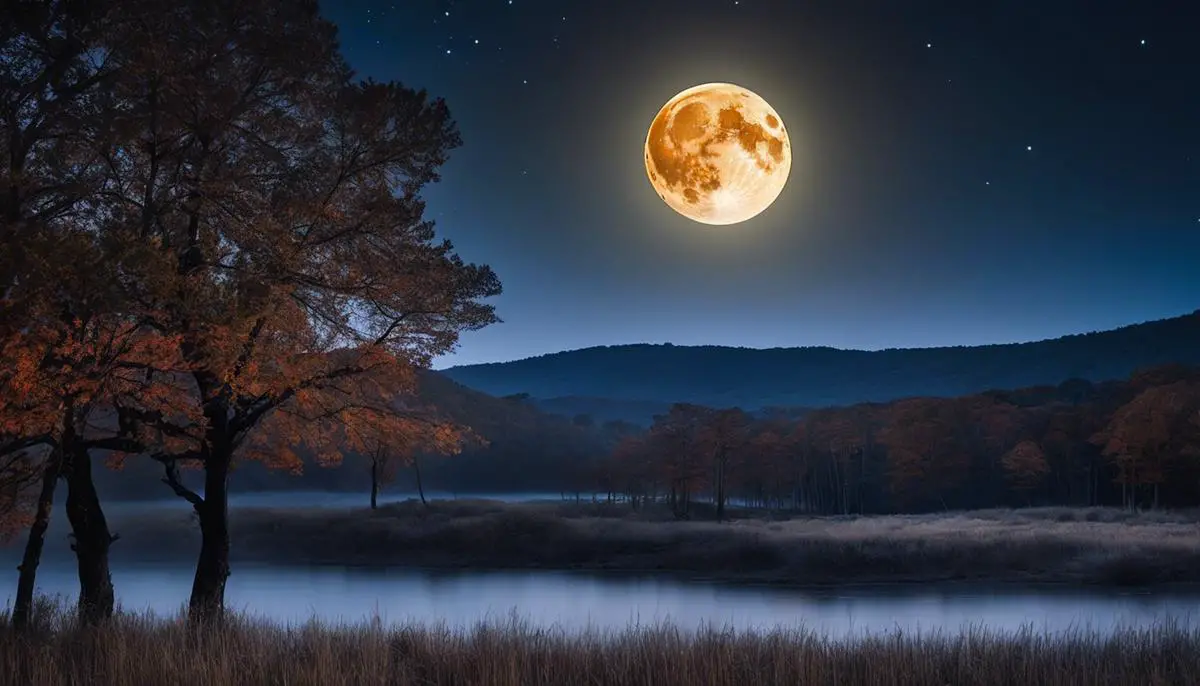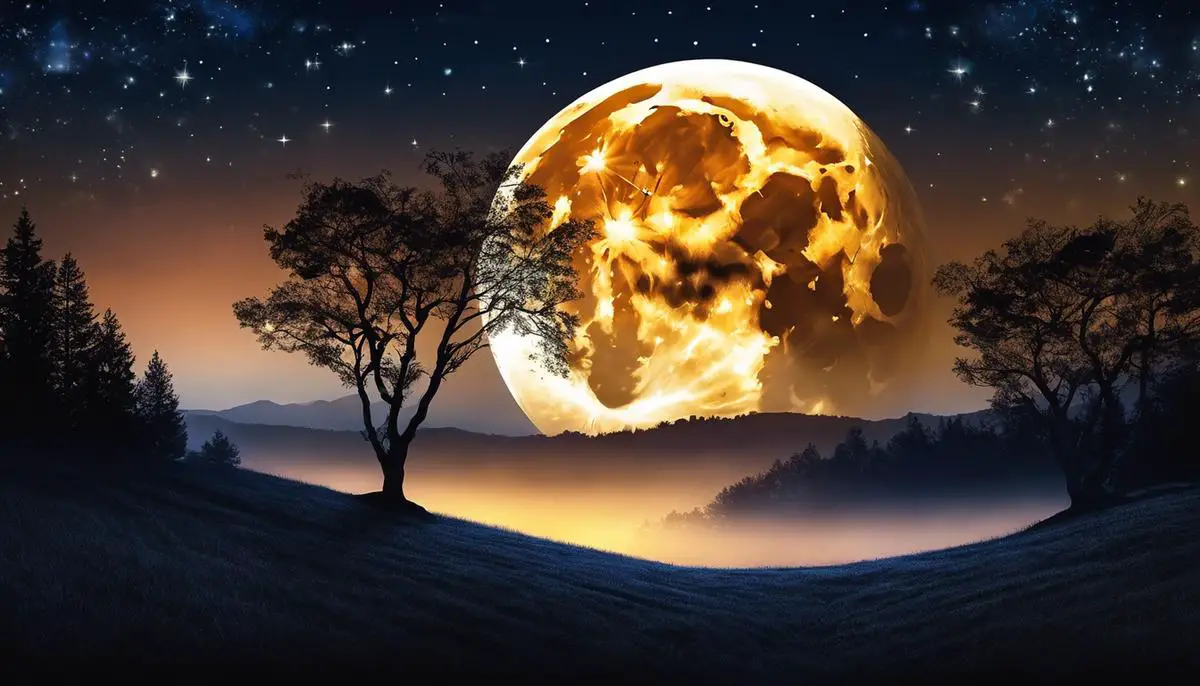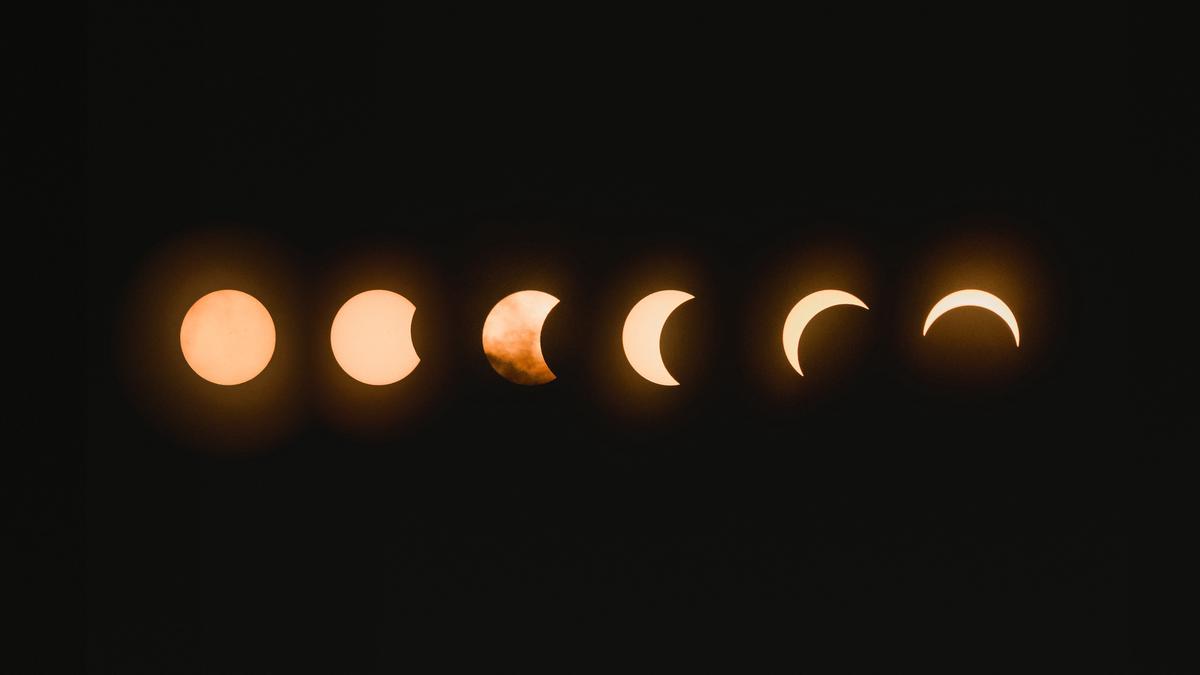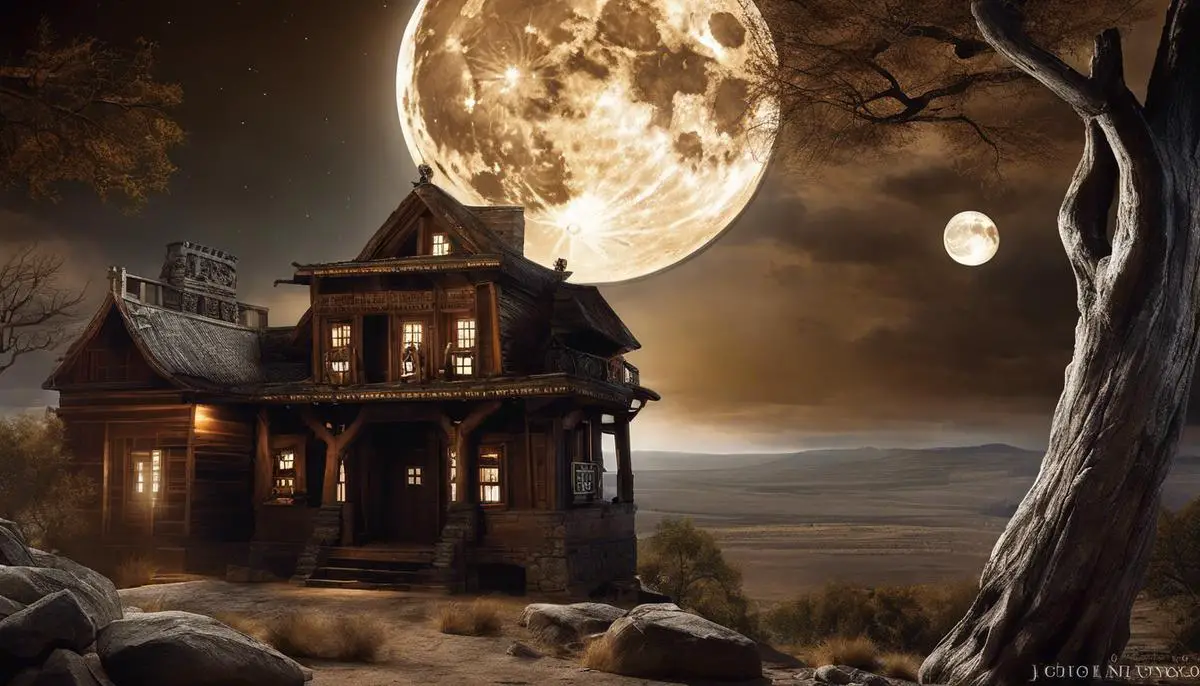In astrology and cultural folklore, there is a compelling connection between lunar occurrences and terrestrial lives. This connection is deeply embedded in our culture and history, giving us events like the Hunter’s Moon. This yearly event, following the fall equinox, signifies the start of the hunting season in many cultures, particularly the Native American tribes. The Hunter’s Moon serves as a linking thread as it intertwines history, culture, scientific principles, and ecological impact in its representation. This discussion delves into understanding the Hunter’s Moon from various aspects – its historical and cultural context, its scientific explanation, and its impact on terrestrial ecology and behavior.
Historical and Cultural Context of a Hunter’s Moon
The Enigmatic Allure of the Hunter’s Moon: A Cultural and Historical Examination
The celestial spectacle that our night sky periodically showcases has always been a source of fascination, offering ample opportunities to delve into a realm of scientific study. Among the many celestial events, the ‘Hunter’s Moon,’ a moniker denoting October’s full moon in the Gregorian calendar, is noteworthy for the intriguing narrative that accompanies it.
Bear in mind, astronomical phenomena like the Hunter’s Moon are not an invention of modern minds, but a result of our planet’s waxing and waning elliptical relationship with our satellite – the Moon. The distinctive hue, size, and timing of the Hunter’s Moon are merely physics at its poetic best.
Often considered an Autumn marvel, the name ‘Hunter’s Moon’ actually originated from past societies, specifically Northern Hemisphere cultures, which relied heavily on hunting and harvesting. For early European civilizations and Native American tribes, abundant moonlight facilitated nocturnal hunting– n critical advantage as winter approached. This harbinger of sustained survival became universally renowned as the ‘Hunter’s Moon.’
Contrary to popular belief, the Hunter’s Moon doesn’t exclusively infer hunting or harvesting. In Celtic tradition, it symbolizes an influential period known as ‘Samhain,’ marking summer’s end and winter’s inception. This transition phase was believed to open communication channels with the spiritual world, placing great significance on the Hunter’s Moon.
Meanwhile, in Asian folklore, the Hunter’s Moon is affiliated with the Mid-Autumn festival or ‘Mooncake’ festival. It’s considered a time for family reunions, moon gazing, and savoring the quintessential mooncakes. The full moon is considered symbolic of unity and completeness in these cultures, underlining the importance of familial bonds.
Understanding this, it’s clear that the Hunter’s Moon isn’t merely a glowing orb in our night sky. Across cultures and historical epochs, the Hunter’s Moon has attained a central role in storytelling and tradition. Engaging in its observation is a shared human experience, bearing witness to the perennial symbiosis between humans and nature and illuminating cultural convergences and divergences at the same time.
Indeed, the Hunter’s Moon is a testament to human fascination with the cosmos, exemplifying our capacity to extract meaning from astronomical phenomena and seek celestial companionship in our terrestrial existence. Unveiling the significance of the Hunter’s Moon elucidates how cosmology, history, and culture are effortlessly intertwined, making the encounter with this October full moon all the more awe-inspiring. Trust that when you next gaze at the illuminated Hunter’s Moon hovering elegantly at the celestial horizon, you’re not only witnessing an astronomical event but partaking in a rich, shared human legacy.
References:
- Bell, T. (2019). The full hunter’s moon in Aries is here to help you reap what you’ve sown. Inverse.
- Hunt, K. (2018). What is a ‘hunter’s moon’ and what does it mean? Bustle.
- NASA. (2020). The next full Moon is the Hunter’s Moon. NASA Science.

Scientific and Astronomical Explanation
Continuing our exploration of the astronomical marvel known as the Hunter’s Moon, we will now delve into the scientific specificity of this natural event. The distinct characteristics of the Hunter’s Moon indeed set it apart from other full moon phenomena. These unique traits involve a multitude of variables from the moon’s orbit to the earth’s axial tilt to the exceptional illumination that comes with the Hunter’s Moon.
The first scientific point to address is the moon’s orbit. At the time of the Hunter’s Moon, the lunar orb has positioned itself to take a somewhat shallow, narrow path across the sky. This direct route results in the moon rising at nearly the same time each night, a notable divergence from the typical 50-minute daily delay in moonrise times. The consistency of the Hunter’s moonrise provides extended periods of light during the early evening, a factor that offered the hunters of yore an extended twilight hunt. Hence, lending to its moniker as the Hunter’s Moon.
Then, there is the matter of Earth’s axial tilt to consider. As the planet spins on its axis, it does so at a somewhat slanted angle known as ‘obliquity.’ This tilt, along with the relative closeness of the Hunter’s Moon to the autumnal equinox, results in the moon having a more southern trajectory across the sky. This southern pathway causes the full moon to appear lower in the sky, complemented by a noticeably warmer hue, a phenomenon brought forth by the abundance of atmospheric particles intervening between us and the lunar spectacle.
To imagine this, consider a sundown scene. As the sun dips towards the horizon, it generally takes up a version of orange or red hues, rich and romantic. This process, referred to by scientists as ‘atmospheric scattering,’ is the exact same mechanism that imparts that characteristic amber glow upon the Hunter’s Moon.
The radiance of the Hunter’s Moon is the subject of much admiration and scientific curiosity. Contrary to contemporary belief, it isn’t inherently brighter in itself. Rather, the augmented brightness results from the moon’s high position in the sky, which reduces the amount of atmospheric interference the moonlight needs to penetrate. This reduced moonlight diffusion creates a more powerful and concentrated stream of lunar luminescence, resulting in the enigmatically enhanced glow of the Hunter’s Moon.
Piecing together these intricate mechanisms, from the moon’s unique path to atmospheric scattering, it isn’t hard to appreciate the fascinating multitude of scientific phenomena at play that brings about the Lucullan display that is the Hunter’s Moon. The story of the Hunter’s Moon indeed serves as an engrossing fusion of anthropological tradition and cosmological precision, enticing to both the cultural enthusiast and the scientific mind. It is a testament to humanity’s enduring fascination with the cosmos, and the ceaseless endeavor to unravel its many mysteries.

Influence and Impact on Ecology and Behavior
Delves into the Impact of the Hunter’s Moon on Wildlife Behavior
Further to the cultural, historical, and astronomical nuances of the Hunter’s Moon, this celestial event plays a pivotal role in altering the behaviour of wild animals – a subject which stays at the heart of many ecologists and zoologists.
There exists a foundational relationship between lunar influences and animal behavior. During the Hunter’s Moon – typically coinciding with the harvest season – the nocturnal luminosity is subtly intensified due to the moon’s proximate orbit. This augmented illumination has a sizable impact on wilderness dynamics that relies on the oscillation of light and dark periods.
Discussing specific wildlife, the Hunter’s Moon significantly alters the foraging patterns of creatures such as nocturnal birds and insects. The incrementally brighter nights extend their hunting hours, as visibility is enhanced by the moon’s intensified reflection. This change may seem trivial, yet, it alters the ecological balance subtly but significantly. Longer hunting hours ensure greater prey availability leading to an overall increase in wildlife activity during this period.
Later research has indicated that this luminary phenomenon, especially the Hunter’s Moon’s intense light and its longer duration, impacts an animal’s physiological functions such as their reproduction patterns and migratory behaviors. Many creatures’ hormonal cycles are dictated by circadian rhythms, which are in turn influenced by light levels. This keeps the web of life intricately connected with celestial patterns.
Increased night luminosity has been observed to affect certain marine life species too; thereby influencing their spawning and feeding patterns. This is seen particularly among corals and invertebrates that rely heavily on the moon’s cycle.
In a broader scope of ecology, these synchronized alterations in the behavior and physiology of varied animal species contribute significantly to the overall biodiversity of the planet. It indirectly influences the distribution of species, their population dynamics, and interactions within their habitats.
It is noteworthy that while the moon-led changes affect the individuals, they also impact the larger continental ecosystems. They shape the temporal patterns and spatial utilization of various habitats, instigating a cascade of changes in migration, breeding, foraging, and predation risks.
Indeed, while the Hunter’s Moon is often perceived for its historical and cultural significance or its stunning visual spectacle, its profound effects run deeper than the surface. It stirs the dynamics of earthly ecosystems and underpins seasonal variations in animal behavior. This celestial event is a reminder of the delicate balance that permeates our intricate web of life. And while this notion may seem more poetic than scientific, it is a remarkable reflection of the interconnectedness of our universe – from the cosmos to the biosphere.

Photo by tegethoff on Unsplash
The enchanting spectacle of the Hunter’s Moon, enhanced by the ‘Moon Illusion’, is not merely a celestial event to anticipate. It is instead a phenomenon deeply entwined with history, cultural beliefs, and ecological rhythms. The radiance cast by this particular full moon illuminates not only our skies but also shows us how our ancestors harmonized their livelihood with natural events. Furthermore, the indirect effects of this lunar occurrence on animal behavior patterns enlightens us about the uncharted influence of cosmic events on our ecology. The mysterious Hunter’s Moon, hence, provides an enticing pathway to understand our inherent bond to space and its phenomena.
![]()
